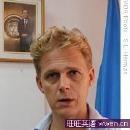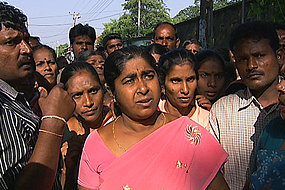Ilankai Tamil Sangam30th Year on the Web Association of Tamils of Sri Lanka in the USA |
||||||
 Home Home Archives Archives |
Sri Lanka: Hell or High Waterby Eric Campbell, ABC News, Australia, February 9, 2010
Watch video here. As many as 40,000 civilians could have been killed during the final stages of the Sri Lankan civil war, according to someone with detailed knowledge of the conflict – the former United Nations’ spokesperson in Sri Lanka, Gordon Weiss. Mr Weiss has resigned from the UN after
14 years and returned home to Australia. He’s now free to speak openly about the situation in Sri Lanka, for the first time and does so candidly and unflinchingly in Foreign Correspondent’s return program.
He acknowledges that the Tamil Tiger forces were also regularly and ruthlessly killing people, to stop them from leaving the battle zones. Claims of Tamil persecution are denied by President Mahinda Rajapaksa, who tells Campbell asylum seekers are criminals – drug dealers and arms traffickers. The President says the problem will disappear and national unity will prevail now that the Tamil Tigers have been destroyed. Tamils prepared to farewell their home, friends and extended families to make the dangerous journey to Australia are a clear indication rhetoric and reality are along way apart. ------------------------------------------------------------------- Up to 40,000 civilians 'died in Sri Lanka offensive' By Andrew Buncombe, Asia Correspondent, The Independent, UK, February 12, 2010 The bitter controversy surrounding the final stages of the Sri Lankan government’s operation to crush separatist rebels has been reopened after a former UN official claimed that up to 40,000 civilians may have been killed. Now, Gordon Weiss, who until the end of last year was the UN’s spokesman in Colombo, has suggested the figure may be much higher. “A lot of civilians died inside the siege zone. I have heard anything between ten and forty thousand people and that’s from reliable sources who had a presence inside the zone,” he told the Australian Broadcasting Corporation. “[The Sri Lankan authorities] repeated a number of things that were either intentionally misleading or were lies. One senior government civil servant remarked at the end of the war that the government insistence that the figures were very low was a ploy. It was a ploy to allow the government to get on with its business.” Last night, the Sri Lankan government dismissed the claims. Lucien Rajakarunanayake, a senior presidential spokesman said: “All I can tell you is that [Mr Weiss] is unaware of the facts. The figures are a total exaggeration. The UN itself has given figures that are much lower than this.” Precisely how many civilians were injured or wounded as Sri Lankan forces defeated the remnant of the LTTE fighters making a final stand in the north east of Sri Lanka, may never be known. At the time, the UN and other organisations claimed that civilians were being struck by ordinance fired by both sides. Testimony provided by Tamils who escaped from the war zone suggests that many civilians were used as human shields by the LTTE as government troops advanced. Mr Weiss was last night unavailable to comment and the UN in Sri Lanka refused to discuss the claims of its former spokesman, believed to be writing a memoir of his experiences in Sri Lanka. In the interview, the former spokesman also suggested there was a need to investigate allegations of possible war crimes. While there have been widespread calls for such an inquiry, including from some senior figures within the UN, the Sri Lankan authorities have refused such an undertaking. “I will not allow any investigation by the United Nations or any other country. There is nothing wrong happening in this country?Take it from me, we will not allow any investigation,” Gotabhaya Rajapaksa, the country’s defence secretary and brother of the president, recently told an interviewer. Indeed, the purported readiness of former army chief Sarath Fonseka to cooperate with such an inquiry has been cited by the government as one of the reasons he was arrested and placed in detention and will likely be placed before a court-martial. Mr Fonseka, who last month failed in his electoral challenge to Sri Lanka’s president, Mahinda Rajapaksa, had said allegations about war could be investigated. The defence secretary said of Mr Fonseka’s undertaking: “He simply cannot do that. For one thing it is a lie.” Yesterday, hundreds of lawyers marched through Colombo to protest against Mr Fonseka’s continued detention. They gathered near the country’s Supreme Court which admitted a petition filed by the former general’s wife that claimed his detention by the military police was illegal. The court has given the government four weeks to reply. Such a date would be less than a month before parliamentary that Mr Fonseka has intended to contest. The government has not yet specified which charges it wishes to bring against him, but has repeatedly claimed he was plotting a coup – something he denied. Meanwhile, the US and Norway denied claims made by the government that they had bankrolled Mr Fonseka’s campaign. In a statement, the US Embassy in Colombo said: “The United States backed no candidate but strongly supported a free, fair, and credible democratic process.” -------------------------------------------------------- UN statement on former spokesman views Office of the United Nations Resident and Humanitarian Coordinator for Sri Lanka, February 15, 2010 A number of queries were made on Mr. Weiss' comments on civilian casualties. The UN repeatedly and publicly said there were unacceptably high civilian casualties from the fighting in the last months of the war, as a result of the LTTE forcibly preventing people leaving and the Government's use of heavy weapons in areas close to thousands of civilians. While we maintained internal estimates of casualties, circumstances did not permit us to independently verify them on the ground, and therefore we do not have verifiable figures of how many casualties there were. The UN remains committed to supporting the Government of Sri Lanka in its efforts to rebuild communities and support peaceful solutions.
|
|||||
|
||||||

